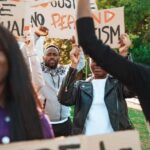By Amber Joseph, 12/5/14 — Our school recently invited presenters from the New York Civil Liberties Union to speak with middle and high school students about their rights and responsibilities during police encounters.
Editor’s Note: The recent decision of two grand juries not to indict officers in the deaths of Eric Garner or Michael Brown have been addressed in hundreds of classrooms throughout the country. Amber Joseph, a New York City middle school teacher, discusses how schools can help students channel their reactions into action.
“These problems did not die with slavery, and are now emerging in huge ways,” one student in my class wrote after Ferguson.
Like many educators around the country, my school has grappled with ways to responsibly frame discussion for a diverse student population with very different backgrounds and levels of awareness about the events.
When our students returned in September, Michael Brown had just been shot, there were protests all over the country and the media – social and traditional – was awash in emotion and information. I asked my students to write all that they knew about what happened in Ferguson. Their responses’ ranged from hearing that “somebody had been shot” to knowing why Missouri Gov. Jay Nixon had called in the National Guard. Because we are a school in New York City, some students confused Brown’s death with that of Eric Garner, an unarmed black man on Staten Island who died in a police chokehold in July.
Our students had lots of questions: what would happen to the police officer? Did Michael Brown have a criminal record? What was the difference between a protest and a riot? They read news articles, watched film clips, looked at social media and news media, and eventually wrote a response to the situation.
Some of my eighth-graders are already being stopped by police, and many others know people in their communities and families who have experienced the New York City Police Department’s controversial “stop and frisk” practices.
To address this issue, our school recently invited presenters from the New York Civil Liberties Union to speak with middle and high school students about their rights and responsibilities during police encounters.
The NYCLU speakers told our students what to do if they are stopped: to remain calm in their tone and body language, they have the right to ask the police offer to identify themselves, and that they have the right to film the encounter. They also handed out pocket-sized cards at the end so that students could have these on their person if they are ever stopped.
One student asked during the presentation, what to do if a cop asks for ID and you don’t have it, a reality for many middle school students. Afterward, one student privately shared that he had been detained by the police before, and he had felt anger long afterwards.
When my students heard about the decision not to indict Ferguson police officer Darren Wilson, they met it with disbelief, then anger. But I felt it was important to channel students’ feelings into action.
Hopelessness ferments when you feel powerless. Our responsibility is to empower students to know that their choices matter, that their actions have an impact on the larger world.
One of my students, after listening politely all class, finally admitted at the end of our discussion of the indictment that he was “tired of hearing about it.” This was a feeling that we must create space for, too.
So, how do we not lose hope? This question is still relevant for both students and those that work with them. There are no ready answers, but listening and talking are forms of action that must continue.
Amber Joseph is an eighth-grade history teacher at East Side Community High School in New York City.
PBS News Hour, Teachers’ Lounge: www.pbs.org/newshour/updates/helping-kids-turn-anger-action-ferguson/










